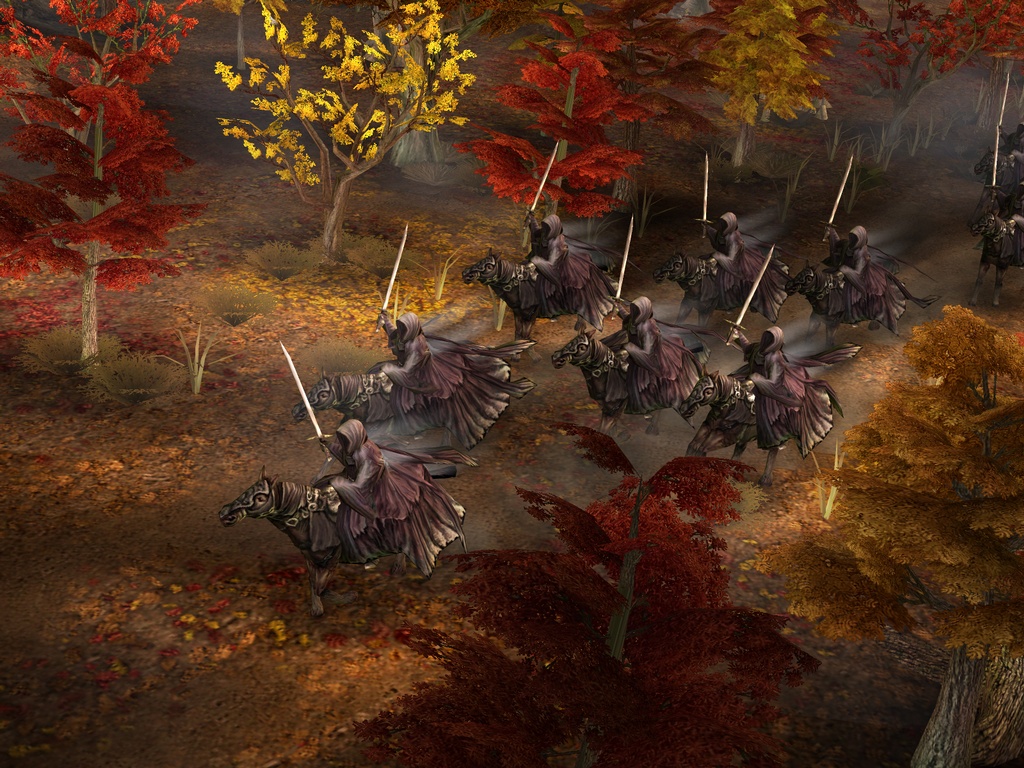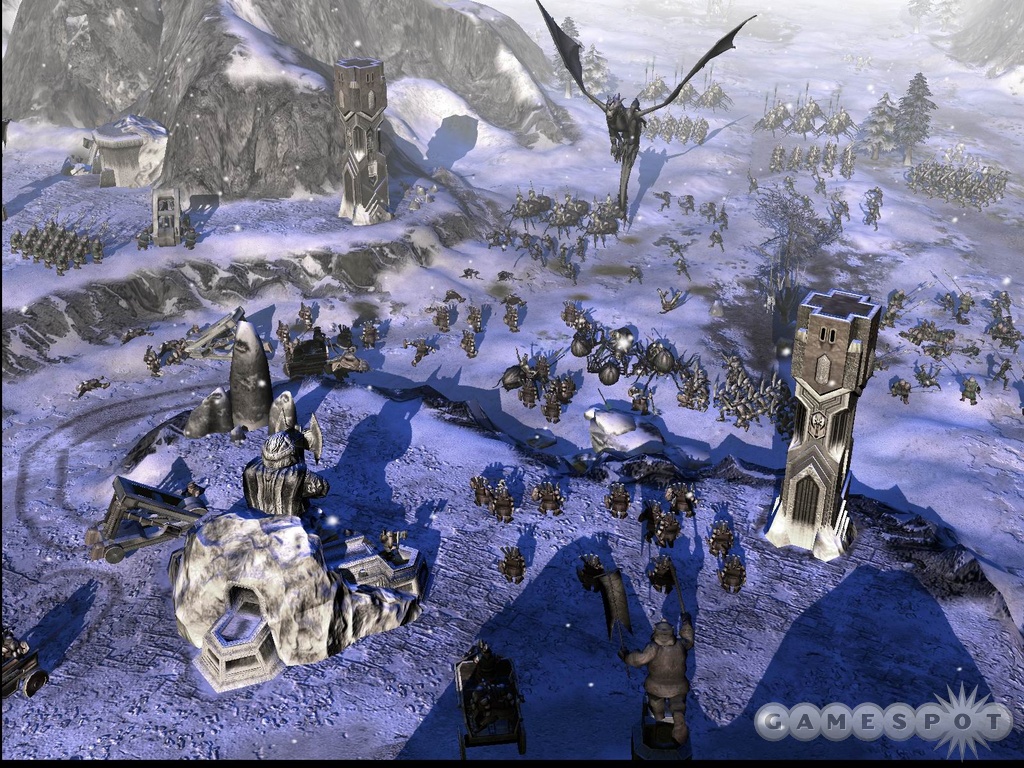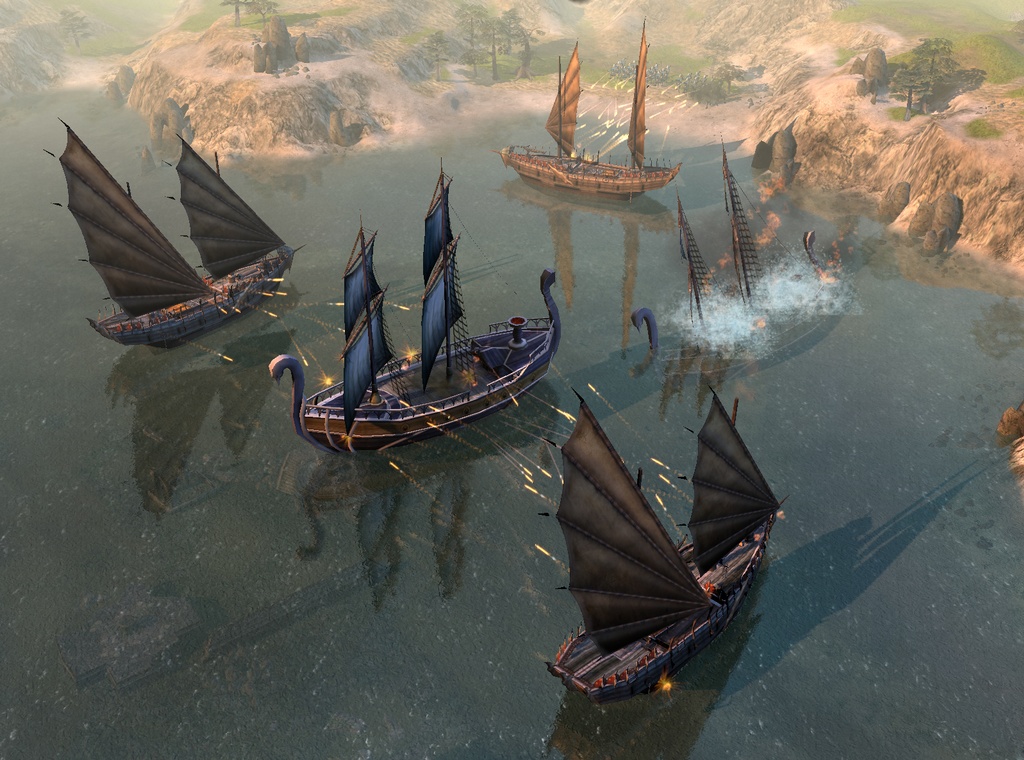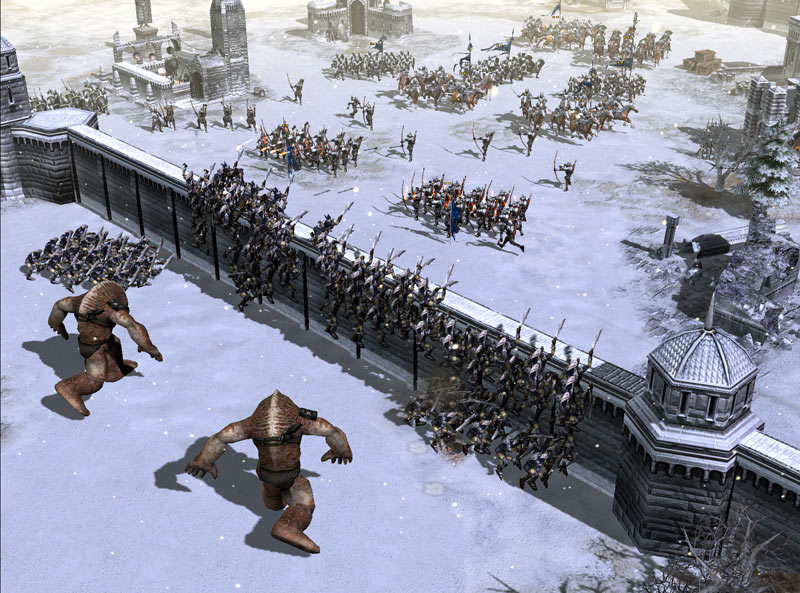The Lord of the Rings, The Battle for Middle-earth II Q&A - Fan Questions, Part II
Senior producer Mike Verdu fields even more fan questions on this upcoming strategy sequel based on the lore of J.R.R. Tolkien.
Battle for Middle-earth II will be the sequel to last year's fast-paced real-time strategy game. Like the first game, the sequel will take place in the fantastical realms of the award-winning Lord of the Rings motion pictures, though the game will also incorporate the lore from the expanded literary works of author J.R.R. Tolkien, whose writings inspired the movies. Senior producer Mike Verdu has fielded the questions of the fan community and answered them--this is the second part of the question-and-answer session.
Question: Are you making any changes to the AI?

Mike Verdu: We are re-writing the AI from the ground up. I think players will be pleasantly surprised at the resulting improvements which range from sophisticated strategies for building and using units, structures, and spell powers to tactics like grouping basic units with heroes to take advantage of what the heroes bring to the party.
Q: What are some of the cool new "big creatures?"
MV: The Giant is a cool new large creature...imagine something twice as tall--and twice as mean--as one of the battle trolls from the movies or the first game. Other interesting big critters include huge dragons, fire breathing drakes, a "Half-Troll" Marauder, and summonable beasties like the giant tentacled monster called the "Watcher" or a Wyrm that tunnels up from underground.
Q: How about spell powers? What's new?
MV: In addition to summonable creatures like the Watcher, you can trigger an earthquake, cause a flood, rain fire down on your opponent's army, call in a whirlwind of destruction, or call allies like Tom Bombadil or the Dunedain to your aid. These are just a few examples of the new powers.
Q: Will more advanced unit commands be available? Such as Hold Position, Automatic Search and Destroy, and so forth?
MV: We are introducing "stances" for units and heroes that give a new level of control over their basic behavior. We are currently implementing three different stances: "Battle Stance," "Hold Ground," and "Aggressive." Units default to the battle stance--they will defend an area but will retaliate if attacked. Units set to hold ground will not budge from their positions even if under attack. Units set to be aggressive will hunt down and kill enemy units that come within their sight ranges.
Q: So what are some of the specific missions or scenarios in the game?
MV: Imagine a massive sea battle outside the Elven port city of the Grey Havens as a fleet of marauding Corsair warships attacks. Or a fight to the death with huge and terrifying dragon in the bowels of the Blue Mountains. Or an assault on a vast Goblin city deep in the Misty Mountains. Or an epic siege on a dark and evil fortress buried in the forests of Mirkwood. These are just a few of the things you'll do in the Good campaign missions--and we're not touching on the Evil campaign or all the cool things you can do in the War of the Ring mode (like defending Minas Tirith with an alliance of Elves and Dwarves).
Q: What's new in multiplayer?
MV: We've made a number of improvements to multiplayer--but the big news is in how we're enabling multiplayer functionality for custom heroes and our new War of the Ring meta-game. You'll be able to create heroes and take them into multiplayer matches. You'll also be able to play a persistent War of the Ring game against another player--with save files. Given that a War of the Ring game with multiple RTS battle sessions might take days to play, we are letting players save out their games so they can pick them up again later.
Some of the more-conventional new features include the ability to set new rules and starting conditions for created games, the ability to establish player handicaps, and other groovy stuff. More details will be forthcoming on the multiplayer feature set a bit later.
Q: What improvements are you making to unit control and tactical fidelity?

MV: You'll be able to create complex formations of troops just by grouping units and moving the mouse--the artificial intelligence will line up formations automatically in an intelligent way (soldiers and pikemen up front, archers in the back, cavalry on the flanks, and siege weapons like catapults in the rear to support attack or defense). This new smart formation system does away with a lot of the micromanagement in the first game (for combo hordes, formations, etc.).
Tactical fidelity in Battle for Middle-earth II will also be much higher--players will get bonuses if they flank their opponents. For example, if you attack a formation from the side, you'll get a bonus in the attack since you're hitting them from a vulnerable angle. Another example: If you ride your cavalry over pikemen while they have their pikes facing the other way, you'll overrun your opponent--unlike the first game, where pikemen slaughtered cavalry no matter which direction their pikes were facing. We heard back from a number of players that they were frustrated because it didn't seem to matter where their units were facing or how they were lined up. We listened and the new game is a lot more realistic without being more complicated.
Q: Are you making any changes to the basic melee system?
MV: Yes--we're implementing a more sophisticated melee combat system that will minimize uncontrollable "scrums." Formations will stay more or less intact and will engage intelligently rather than simply piling into each other in an unmanageable mass of troops. We want to make sure you can still control the action even in a big battle.
Q: How will naval combat work?
MV: You'll be able to capture a neutral Shipwright structure and then build ships that are appropriate to your side. If you're playing Elves, Dwarves, or Men of the West, you'll be able to build Elven warships and transports. Goblin, Mordor, and Isengard players will get Corsair warships and transports. Warships can be upgraded to get improved armor, firepower, etc. You can use ships to bombard units and structures inland, battle against other ships, or scout the map.
Q: Why combine Gondor and Rohan? What other changes are there to existing sides?
It made sense to combine Gondor and Rohan into one faction--the Men of the West--because these two sides had duplicate unit types and Rohan was really just about heroes and cavalry. By adding the Rohan heroes to Gondor and making the Rohirrim horsemen available as cavalry, the new unified Men of the West is a deep, rich, and compelling side.
Mordor and Isengard are already pretty cool sides and it didn't seem right to combine them. Instead, we're adding a bunch of units and heroes to both Mordor and Isengard to increase depth. For example, we gave Mordor the Black Riders (Ring Wraiths on horseback), Corsairs of Umbar (able to scale walls using grappling hooks), and a new Mouth of Sauron hero, among other additions. Isengard gained the Wild Men of Dunland as units, Wormtongue, and Sharku the Warg Hero. Both sides also got new customizable fortress structures with all sorts of cool upgrades.
Q: How many people are working on the project?
MV: We reached peak staffing of about 80 people in June (this number doesn't include our testers). This is a big team made up of very talented individuals. I'm continually amazed--and delighted--by how quickly this team is making progress on the game.
Q: Will there be an expansion pack for the original Battle for Middle-earth?
MV: We looked seriously at creating an expansion pack for Battle for Middle-earth but the opportunity presented by the consolidated book and movie rights for The Lord of the Rings led us to make a full sequel instead. The unified rights unlocked the world of Middle-earth like never before...it's a once-in-a-lifetime chance to work on a game that brings new races, places, heroes, and battles from the books into the visual world of the films.
With a full team of 80 very talented people, we set a very ambitious agenda: to make enough new content for a full sequel and then bring along all the units, structures, and locations from the first game, to push to innovate within the genre, to transform the base-building experience with a powerful fortress and wall building system that's incredibly easy to use, to create a strategy meta-game that can be played against other players and not just an AI, to make something that gives the game infinite replayability in the single player experience, to unlock the ability to create custom RTS heroes and take them on-line, to give players better control over armies in combat without adding a bunch of complexity, to make substantial upgrades to the engine so that we could dramatically improve the visual quality of the world, and finally to ake a game that's addictive, fun to play, and appeals to our traditional hard core RTS gamers without losing the accessibility and ease of use that distinguished the first game.
Q: Will you be able to have your troops walk and fight on the walls you can build as part of the new fortress and wall system?

MV: The ability to walk--and fight--on top of walls was in our design spec for the new base building system from the beginning. We implemented large "walk-able walls" in May and tested them in play sessions--and unfortunately we discovered that the oversized wall hubs and wall segments weren't a lot of fun to play with because they were huge, awkward, and ugly to boot. The smaller and more-upgradeable walls, on the other hand, were a blast to play with and were an instant hit. These smaller walls are the right size for the game and make up for the lack of "walk-able" space by having every wall segment available for upgrades with towers, gates, trebuchets, and so on. We made a call to leave the larger walk-able walls out of the game. We are actually looking into the idea of making them accessible to the mod community.
Please remember that large pre-built castles in specific maps (like Helm's Deep and Minas Tirith) will have the larger walk-able walls; we just decided to sacrifice walk-able walls for player-created castles using the new base building system.
Q: Will you have more units on the screen than in the first game? Are you changing the population cap?
MV: We will let you have more units on the screen in Battle for Middle-earth II--but I don't want to commit to a hard number just yet. As for the pop cap, that was our way of controlling the number of units that appeared on the screen; we won't be lowering it.
Q: Will there be more units per horde or battalion?
MV: Yes. The larger hordes and battalions give the game a "big army" feeling and make it easier to use some of our new unit control and tactical fidelity features (like smart formations and flanking).
Q: Will units still have emotions?
MV: Yes. We're implementing emotions for the new units that we're adding and we're tuning the emotion system from the first game. It's pretty cool to have your units react like characters: they still cheer in triumph, taunt enemies, tremble in fear, and exhibit other visible behaviors in response to changes in the environment and the game state.
Got a news tip or want to contact us directly? Email news@gamespot.com

Join the conversation